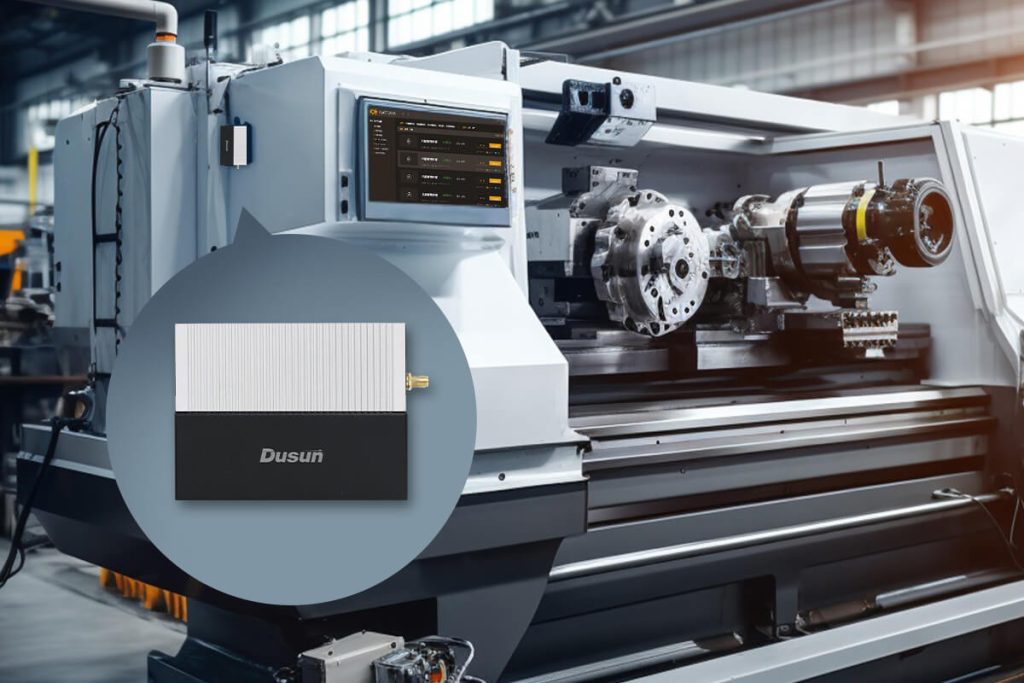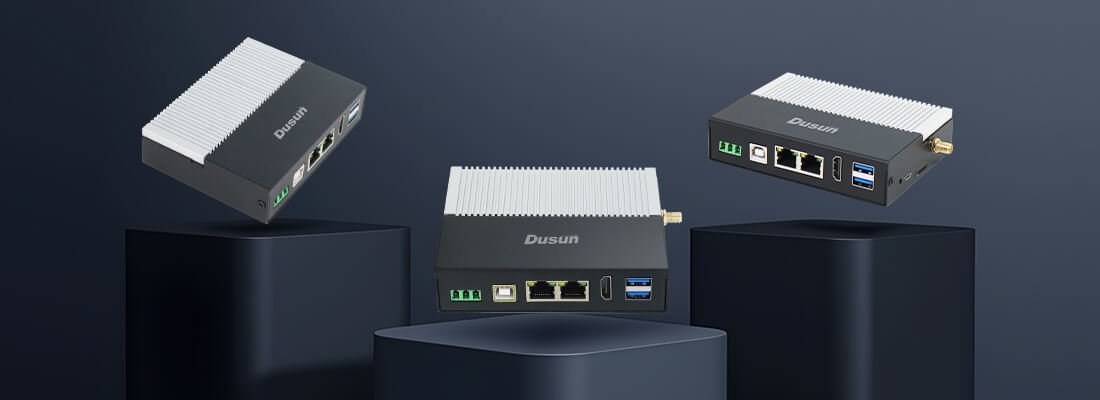Since then, many industrial equipment owners, especially in manufacturing factories, have been looking for ways to upgrade their existing equipment to harness the power of modern IIoT and implement Industry 4.0. Ideally, this upgrade solution should be low-cost and cause minimal disruption to the industrial processes.
Industrial revolutions from 1.0 to 4.0
Dusun IoT’s DSGK-061 edge computing AI box fits this description, but more on that later. Let’s first look at the benefits of upgrading industrial equipment.
Source from: https://en.wikipedia.org/wiki/Fourth_Industrial_Revolution
Benefits of Upgrade or Modernize Industrial Equipment
To Eliminate Unplanned Downtimes
Old and unreliable machinery can break down at any time, resulting in unplanned outages that interrupt manufacturing and reduce productivity. Upgrading or retrofitting these equipment eliminates these unplanned interruptions, and the best way to go about it is to use modern, tried-and-tested technology.
The upgrade might seem expensive, but it is cheaper than the costs associated with downtime and replacing the old with the new.
Also Read: IoT-based Predictive Maintenance
To Improve Performance and Efficiency
The entire IoT manufacturing process in modern factories is interconnected to the point where any delay in one sector can cause delays in the entire production. Old and outdated machines tend to operate at lower efficiencies, which can slow down the whole plant and magnify the inefficiencies.
Updating the equipment restores the required efficiency, which maximizes productivity and cuts the production costs per item.
To Increase Production Time
Minimal downtime combined with better performance and efficiency automatically increases production time. Additionally, the new machinery can have simpler HMI user interfaces with more features that enable automation or fewer workers to handle more tasks.
An HMI user interface
To Enhance Product Quality
Upgrading to the latest machinery has a positive effect on product quality, especially in segments where high precision, fine tolerances, and high standards are required.
This benefit is critical because it keeps companies ahead of the competition and enables them to access new markets with stringent quality standards.
To Improve Workplace Safety
New equipment usually features more fail-safe mechanisms that improve worker safety by reducing hazards and potentially eliminating workplace injuries.
To Improve Sustainability
The efficiency provided by modern machines helps to reduce energy consumption and material wastage, which indirectly reduces harmful gas emissions. This benefit also helps reduce production costs (energy and materials), making it possible to lower prices and remain competitive.
To Make Access To Support and Repair Parts Easier
Machine and equipment manufacturers usually provide support and repair parts for each version for a specific period. Therefore, hanging on to old machines can be costly because they break down often, and finding parts or technical support will be challenging to bring them back to life. Some equipment manufacturers might have even gone out of business, so getting repair parts will be impossible.
To Maximize ROI
Modern machines and equipment enable companies to recoup their investments faster by improving productivity, reducing maintenance costs, and cutting production costs, especially those associated with energy consumption.
Read Cases: Multiple Zigbee Gateway for Energy Management
Introducing Dusun IoT’s DSGK-061 Edge Computing AI Box for Industrial Equipment Upgrade
I had mentioned DSGK-061 smart edge computing AI box earlier, this box makes it possible to modernize factory machinery to achieve Industry 4.0 cheaply in four ways.
Providing Local Visualization
Some early-age industrial equipment lacks displays to show what’s happening around the industrial processes. DSGK-061 features an HDMI interface with a 4096×2304 maximum resolution and 60Hz refresh rate to provide image viewing and analysis in industrial control, medical, and other applications.
This makes it a cheaper alternative than having to replace entire machines with new ones that have HMIs.
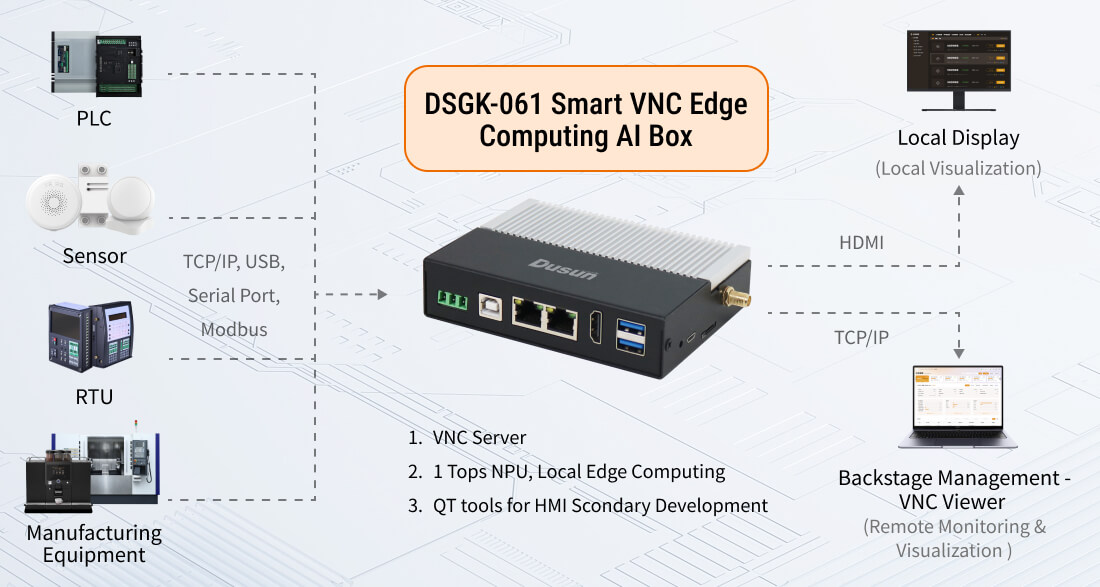
Enabling Remote Access, Operation and Management
Speaking of HMI, this smart box features VNC remote access and supports TCP/IP to upgrade existing traditional HMIs by providing remote access.
Usually, traditional HMIs are located on-site and don’t allow remote access. But the DSGK-061 sits behind them in the architecture to act as a VNC server. This leaves the HMI to be a VNC viewer. On the other side are protocols like Modbus and TCP/IP to interface with the machines, sensors, PLCs, and RTUs, so the box converts protocols when providing remote control.
This setup enables factory workers and other users to remotely access, configure, maintain, monitor, and control industrial equipment, including traditional screenless machines, using devices like phones and laptops.
Remote control is convenient because it allows technicians to keep tabs on industrial processes even after clocking out or when on other assignments.
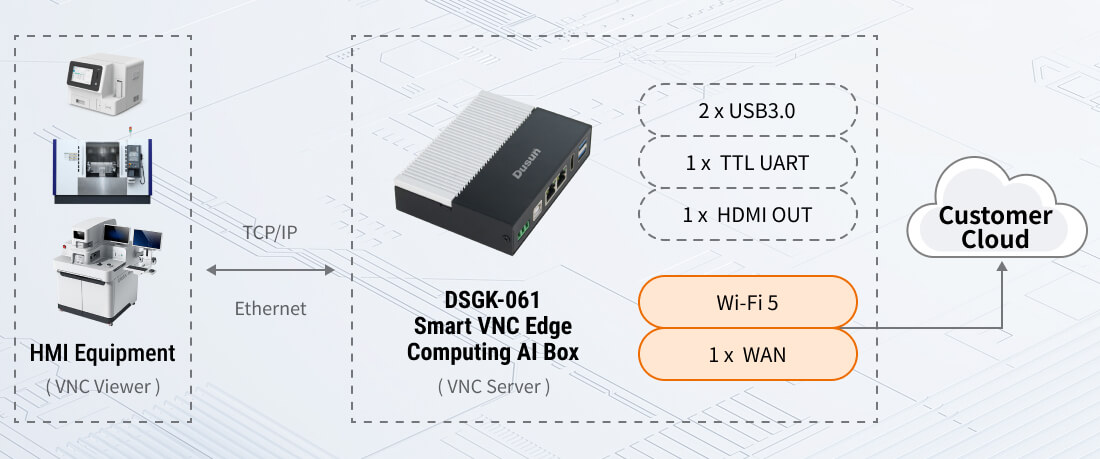
Allowing Secondary Development
Traditional HMIs are often closed, with limited openness to make secondary development for more features. But this smart edge computing box changes that because it allows QT toolchain secondary development. It runs on Android 12, providing a highly open platform for developing, customizing, and installing applications.
Dusun IoT provides rich development resources, including MQTT protocol support, open-source SDKs, and SAE assistance to solve app development technical challenges.
With the apps up and running, users can use the local monitor or VNC viewers (via Wi-Fi or WAN) to access these additional tools to monitor, control, or run the entire factory more efficiently.
Providing Lightweight AI Power for Local Edge Computing
The DSGK-061 provides local edge computing power for automation and other tasks because it runs on a quad-core Cortex A55 CPU and has up to 4GB RAM with 32GB eMMC. This chip has an integrated 1 TOPS NPU that can run lightweight 3D rendering and other AI tasks, making it suitable for call centers, medical facilities, e-classrooms, corporate offices, etc.
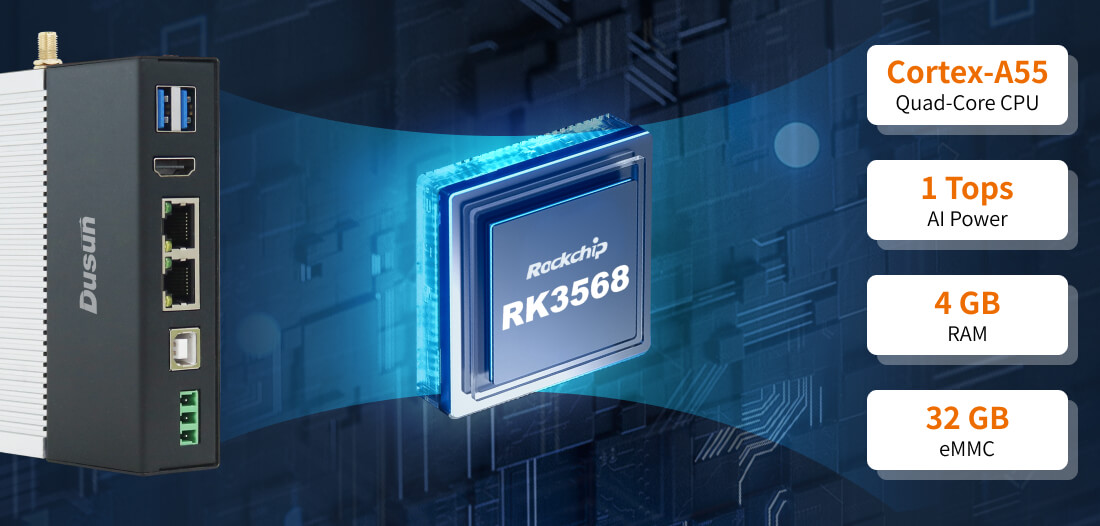
Working as a Thin Client Computer
Additionally, the smart AI box can function as a thin client, connecting to the customer’s cloud using the IDV (Intelligent Desktop Virtualization) architecture for centralized data management. This enables more complex processing tasks to be done on the servers. It is worth noting this box also supports the traditional Virtual Desktop Infrastructure architecture.
Also read: What is Thin Client Computer?
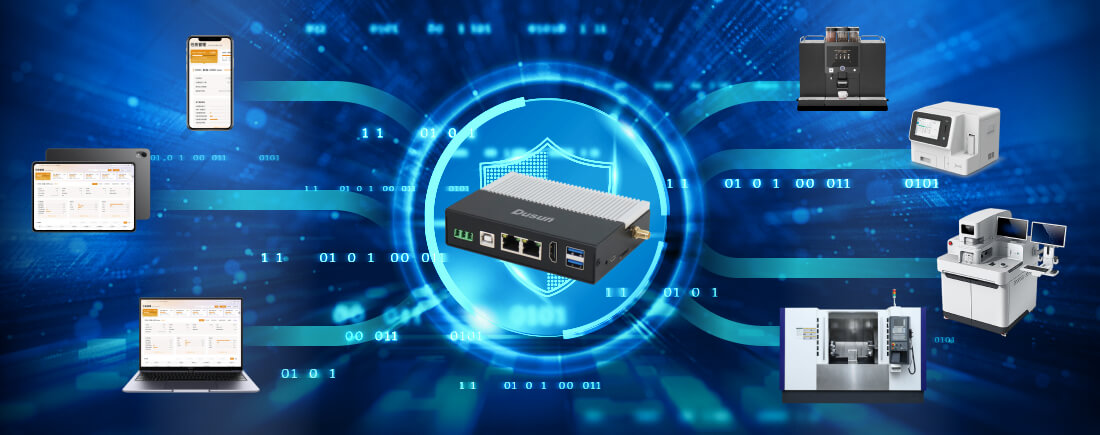
How to Upgrade Industrial Equipment? Step-by-step Tutorial
Step 1: Assess Your Equipment Needs
Before upgrading industrial equipment, assess the machine’s requirements that will enable it to achieve maximum efficiency. This will help to identify gaps or room for improvement. You can carry out this assessment by:
- Doing an equipment inventory
- Checking the machine’s specifications
- Analyzing the equipment’s condition
- Checking the equipment’s usage
You can get some of this data from the quality, production, and maintenance records, then prioritize the equipment needs based on importance and cost.
Step 2: Implement Preventive Maintenance
Preventive maintenance helps to reduce downtime, wastage, and inefficiencies while increasing product quality and extending the equipment’s lifespan. For effective preventive maintenance, develop schedules and checklists for every machine, train technicians to perform this maintenance, follow the procedures consistently, and document the results.
Step 3: Upgrade Your Equipment Strategically
This process must be handled strategically because it can be costly, risky, and disruptive. Consider the cost-benefit analysis, ROI, training requirements, compatibility issues, and other factors to ensure a smooth upgrade.
Step 4: Monitor and Evaluate Your Equipment Performance
For starters, you must have indicators, metrics, and benchmarks to compare your data for evaluation. With this in place, monitor and collect data from the equipment using sensors and meters, then use software to store and analyze this data.
Check for improvements after the maintenance and upgrades, and adjust the parameters accordingly to achieve optimum efficiency.
Step 5: Seek Expert Advice and Support
The insights derived from the analyzed sensor data should help you make better-informed decisions. However, you should seek expert advice and support to gain new insights, perspectives, and solutions for the equipment’s challenges and needs.
These experts should include reputable persons, such as consultants, equipment suppliers, researchers, or industry association members. Remember to convey your needs and expectations clearly to them for fruitful collaborations.
Step 6: Involve and Empower Your Staff
Employees should be part of the maintenance and upgrading process to adopt the new system as early as possible. So encourage them to share their ideas, concerns, and suggestions to help make critical decisions and solve challenges during the process.
Involving and empowering them can also boost their morale, retention, and motivation, and you can leverage their knowledge, skills, and feedback to improve the equipment’s quality and performance.
Final Words
Modernizing and upgrading industrial equipment might seem like a simple thing to do on paper, but the actual implementation requires skill and precision. This upgrade is necessary if you want to leverage the power of Industry 4.0, and Dusun IoT’s DSGK-061 smart edge computing AI box makes the process much easier and cheaper because this small device can do a lot.
However, ensure you follow the steps above during this process to make it more effective, and our team is available to provide expert advice and support to make the solution implementation as seamless and beneficial as possible. That’s it for this article. You can learn more about this smart box here to understand its full features and capabilities.









